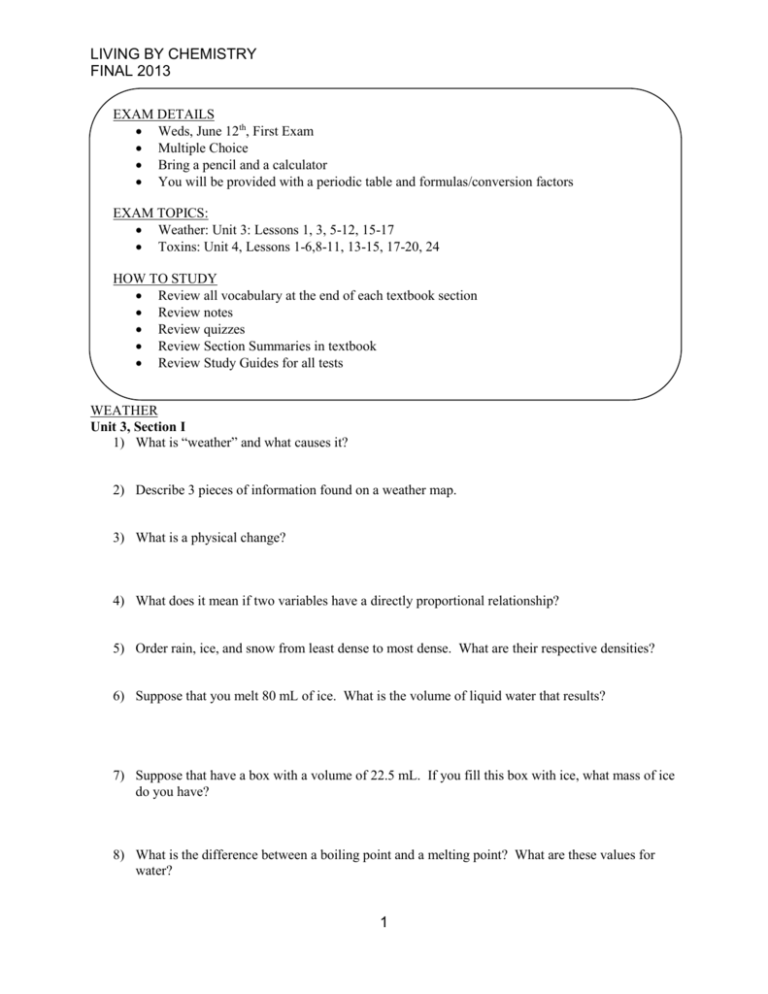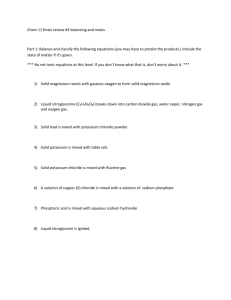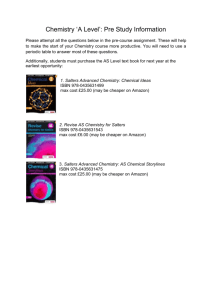LIVING BY CHEMISTRY FINAL 2013 EXAM DETAILS Weds, June
advertisement

LIVING BY CHEMISTRY FINAL 2013 EXAM DETAILS Weds, June 12th, First Exam Multiple Choice Bring a pencil and a calculator You will be provided with a periodic table and formulas/conversion factors EXAM TOPICS: Weather: Unit 3: Lessons 1, 3, 5-12, 15-17 Toxins: Unit 4, Lessons 1-6,8-11, 13-15, 17-20, 24 HOW TO STUDY Review all vocabulary at the end of each textbook section Review notes Review quizzes Review Section Summaries in textbook Review Study Guides for all tests WEATHER Unit 3, Section I 1) What is “weather” and what causes it? 2) Describe 3 pieces of information found on a weather map. 3) What is a physical change? 4) What does it mean if two variables have a directly proportional relationship? 5) Order rain, ice, and snow from least dense to most dense. What are their respective densities? 6) Suppose that you melt 80 mL of ice. What is the volume of liquid water that results? 7) Suppose that have a box with a volume of 22.5 mL. If you fill this box with ice, what mass of ice do you have? 8) What is the difference between a boiling point and a melting point? What are these values for water? 1 LIVING BY CHEMISTRY FINAL 2013 9) What is “absolute zero”? 10) Define temperature. 11) According to the kinetic theory of gases, describe how particles in a sample of gas move. 12) Which gas variables does Charles’s Law explain? What is the relationship between these variables? 13) A. 4.5 L gas sample at 20°C must be cooled to what temperature for the volume to change to 1.0 L? 14) A man heats a balloon in the oven. If the balloon initially has a volume of 0.6 liters and a temperature of 25 0C, what will the volume of the balloon be after he heats it to a temperature of 225 0C? 15) A soda bottle is flexible enough that the volume of the bottle can change even without opening it. If you have an empty soda bottle (volume of 2 L) at room temperature (25 0C), what will the new volume be if you put it in your freezer (-4 0C)? 16) When does a cold front occur? How is it related to density? 17) A warm front is approaching your hometown and is due to arrive tomorrow. What kind of weather would you expect to observe? Which symbol on a weather map would show the front? 2 LIVING BY CHEMISTRY FINAL 2013 Unit 3, Section II 18) Describe sublimation. What type of change is this? 19) List the densities of gases, solids, and liquids from most dense to least dense. 20) When water freezes, the water molecules move apart very slightly. What evidence can you provide to support this claim? 21) Draw a molecular view for water vapor, liquid water, and ice. 22) What is the volume of 10.0 g CO2(s)? (The density is 1.56 g/mL) 23) Explain what causes air pressure. 24) Which gas variables does Boyle’s Law explain? What is the relationship between these variables? 25) Sketch a graph of P vs. V. Then sketch a graph of P vs. 1/V. 26) Which variables does Charles’s law explain? What is the relationship between these variables? 27) If 1.00 L of a gas at standard temperature and pressure is compressed to 473 mL. What is the new pressure of the gas? 3 LIVING BY CHEMISTRY FINAL 2013 28) Synthetic diamonds can be manufactured at pressures of 6.00 x 104 atm. If we took 2.00 liters of gas at 1.00 atm and compressed it to a pressure of 6.00 x 104 atm, what would the volume of that gas be? 29) Which gas variables does Gay-Lussac’s Law explain? What is the relationship between these variables? 30) A scuba-diving tank holds 21 L of air at a pressure of 38 atm. If the temperature does not change, what volume would this same air occupy if it were allowed to expand until it reached a pressure of 1.0 atm? 31) Use the kinetic theory of gases to explain why decreasing the gas temperature decreases the gas pressure. 32) How are areas of high and low pressure related to the weather? 33) Which gas law contains variables that are inversely proportional? What does this mean? Unit 4, Section I 34) a) Write a written interpretation of the following chemical equation: 2HCl(aq) + Cr(s) CrCl2(aq) + H2(g) b. What are the reactants and products? What do the symbols in parentheses mean? What is the difference between a subscript and a coefficient? 4 LIVING BY CHEMISTRY FINAL 2013 35) Toxic substances may be molecular, ionic, or metallic. Categorize the following compounds as ionic, molecular, or metallic: a. CH4O b. Al c. Ca(OH)2 d. Sn e. CaO 36) Describe at least three types of effects that a toxic substance can have on the body. 37) Write a chemical equation showing sodium chloride melting. 38) Write a balanced chemical equation for these reaction descriptions: a. Solid sodium chloride dissolves in water. b. Solid calcium sulfide is heated to produce solid calcium and sulfur gas. c. Solid sodium and chlorine gas yield solid sodium chloride. 39) The diatomic elements are: 40) What is the difference between a physical change and a chemical change? 41) Classify the following as physical or chemical changes: a. Water freezes. d. Iron rusts. b. Methane burns. e. Carbon dioxide sublimes. c. Calcium chloride decomposes. f. A paper is folded. 42) Classify the following as physical or chemical changes: a. NH2Cl(g) NH2Cl(aq) b. 2CH4O(l) + O2(g) 2CH2O(l) + 2H2O(l) c. Hg(l) Hg(g) d. CaO(s) + H2O(l) Ca(OH)2(s) 5 LIVING BY CHEMISTRY FINAL 2013 43) Explain the law of conservation of mass. 44) Balance the following chemical equations: a. S8 + O2 SO3 b. H3PO4 H4P2O7 + H2O c. N2 + O2 N2O d. Fe2(SO4)3 + KOH K2SO4 + Fe(OH)3 e. FeS2 + O2 Fe2O3 + SO2 f. P4 + O2 P2O5 g. CH4 + O2 CO2 + H2O 45) Write and balance the following chemical equations: a. Potassium oxide + water potassium hydroxide b. aluminum oxide aluminum + oxygen c. iron(III) chloride + ammonium hydroxide iron(III) hydroxide + ammonium chloride d. aluminum + hydrogen chloride aluminum chloride + hydrogen 46) Classify the type of reaction for the equations in #51. 6 LIVING BY CHEMISTRY FINAL 2013 47) List all of the phase changes between solids, liquids, and gases: Solid Liquid Gas Unit 4, Section II 48) What is “counting by weighing” and when is it useful? 49) A lentil has a mass of 0.056 g. A sample of lentils is measured to have a total mass of 400 g. How many lentils are in the sample? 50) A lentil is measured on a balance to have a mass of 0.054 g. What is the % error in this measurement? 51) What is a mole? 52) Define molar mass. 53) Describe in words how to convert from mass to moles. 54) Describe in words how to convert from moles to # of particles. 55) What is the molar mass of: a. Ir b. Mn c. Cu2O 7 d. (NH4)3PO4 LIVING BY CHEMISTRY FINAL 2013 56) a) I have 400 g of iridium. How many moles is this? b) How many atoms of Ir do I have? 57) How many grams are in 2.65 moles of Cu2O? 58) A glass holds 50 g of H2O. How many molecules are in the glass? 59) Which is more toxic: 1 mol of Hg or 10 g of Hg? Explain. 60) Which has more mass: 5 moles of Cu2O or 10 moles of CuO? Unit 4, Section III 61) What is the difference between a homogeneous mixture and a heterogeneous mixture? 62) What is a solution? What are the two parts of a solution? 63) How do chemists express the concentration of a solution? 64) Determine the molarity of the following solutions: a. 5 mol NaCl in 5 L of solution: b. 8 mol NaCl in 400 mL solution: c. 30 g NaCl in 1 L solution 8 LIVING BY CHEMISTRY FINAL 2013 65) What portion of 2.0 L of 0.50M blue dye solution contains the same number of moles as 2.0 L of a 0.25M blue dye solution? 66) How many moles of Na+ are in: a. 0.50M NaCl b. 2.5M Na2CO3 67) Draw a picture of a 1.0M solution, 0.5M solution, and 2.0M solution. 68) How many liters of solution would contain 0.25 mol NaCl in a 2.5M solution? 69) How many moles of HCl are in 250 mL of a 1.5M solution? 70) Describe the procedure and show the calculations for creating 500 mL of a 0.4M Kool-Aid solution. (The molar mass of KoolAid is 342 g/mol) Unit 4, Section IV 71) What are some general properties of acids and bases? 72) What is the pH scale? Where do acids, bases, and neutral substances fall on it? 73) Give two examples of an indicator. What is the purpose of using an indicator? 74) What is the Arrhenius definition of an acid and a base? Provide an example of each. 9 LIVING BY CHEMISTRY FINAL 2013 75) What is the Bronsted-Lowry definition of an acid and a base? Provide an example of each. 76) Are the following examples acids or bases? a. slippery feeling f. distilled water b. NaOH g. H2CO3 c. hydrochloric acid h. Ca(OH)2 d. drain cleaner i. barium hydroxide e. pH=2 j. pH = 11 77) What is “dissociation”? How does HCl dissociate in water? How does NaOH dissociate in water? 78) How are weak acids different from strong acids? 79) What does it mean that the pH scale is a logarithmic scale? 80) Which is more acidic: pH=2 or pH=4? How much more acidic is the stronger acid? 81) Determine the following pH values: a. [H+] = 1.0 x 10-4 d. pOH=8 b. [H+] = 1.0 x 10-8 e. [OH-] = 1.0 x 10-9 c. 2.5M HCl 82) How much water do you need to add to 50 mL of a solution to change the pH from 3 to 5. 83) a) How many moles of H+ are in 0.75 L of 0.25M HCl? b) If you add 15 mL of water, what is the new concentration? 10








